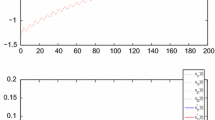Abstract
We give a detailed analysis on convergence for a class of non-autonomous shunting inhibitory cellular neural networks involving multi-proportional delays. By employing the differential inequality techniques, we establish a novel result to ensure that all solutions of the addressed system converge exponentially to zero vector. Moreover, numerical simulations supporting our theoretical results are also included.

Similar content being viewed by others
References
Ockendon JR, Tayler AB (1971) The dynamics of a current collection system for an electric locomotive. Proc R Soc A 322:447–468
Fox L, Mayers DF, Ockendon JR, Tayler AB (1971) On a functional-differential equation. J Inst Math Appl 8(3):271–307
Derfel GA (1982) On the behaviour of the solutions of functional and functional-differential equations with several deviating arguments. Ukr Math J 34:286–291
Song X, Zhao P, Xing Z, Peng J (2015) Global asymptotic stability of CNNs with impulses and multi-proportional delays. Math Methods Appl Sci. doi:10.1002/mma.3515
Derfel GA (1990) Kato problem for functional-differential equations and difference Schrödinger operators. Oper Theory 46:319–321
Xu Y (2014) New results on almost periodic solutions for CNNs with time-varying leakage delays. Neural Comput Appl 25:1293–1302
Chen Z (2013) A shunting inhibitory cellular neural network with leakage delays and continuously distributed delays of neutral type. Neural Comput Appl 23:2429–2434
Zhang A (2015) New results on exponential convergence for cellular neural networks with continuously distributed leakage delays. Neural Process Lett 41:421–433
Liu X (2015) Improved convergence criteria for HCNNs with delays and oscillating coefficients in leakage terms. Neural Comput Appl. doi:10.1007/s00521-015-1906-z
Liu X (2015) Exponential convergence of SICNNs with delays and oscillating coefficients in leakage terms. Neurocomputing 168:500–504
Long Z (2016) New results on anti-periodic solutions for SICNNs with oscillating coefficients in leakage terms. Neurocomputing 171:503–509
Zhang Y, Zhou L (2012) Exponential stability of a class of cellular neural networks with multi-pantograph delays. Acta Electron Sin 40(6):1159–1163
Zhou L (2013) Delay-dependent exponential stability of cellular neural networks with multi-proportional delays. Neural Process Lett 38:347–359
Zhou L, Liu J (2013) Global asymptotic stability of a class of cellular neural networks with proportional delays. Chin J Eng Math 5(30):673–682
Zhou L, Zhang Y (2015) Global exponential stability of cellular neural networks with multi-proportional delays. Int J Biomath 8(6):1–17
Zhou L (2015) Novel global exponential stability criteria for hybrid BAM neural networks with proportional delays. Neurocomputing 161:99–106
Bouzerdoum A, Pinter RB (1993) Shunting inhibitory cellular neural networks: derivation and stability analysis. IEEE Trans Circuits Syst 1 Fundam Theory Appl 40:215–221
Bouzerdoum A, Pinter RB (1991) Analysis and analog implementation of directionally sensitive shunting inhibitory cellular neural networks. Vis Inf Process Neurons Chips SPIE–1473:29–38
Bouzerdoum A, Pinter RB (1992) Nonlinear lateral inhibition applied to motion detection in the fly visual system. In: Pinter RB, Nabet B (eds) Nonlinear vision. CRC Press, Boca Raton, pp 423–450
Ou C (2009) Almost periodic solutions for shunting inhibitory cellular neural networks. Nonlinear Anal Real World Appl 10:2652–2658
Zhao C, Wang Z (2015) Exponential convergence of a SICNN with leakage delays and continuously distributed delays of neutral type. Neural Process Lett 41:239–247
Liu B (2009) New convergence behavior of solutions to shunting inhibitory cellular neural networks with unbounded delays and time-varying coefficients. Appl Math Modell 33(1):54–60
Meng H, Li Y (2008) New convergence behavior of shunting inhibitory cellular neural networks with time-varying coefficients. Appl Math Lett 21(7):717–721
Stamova IM, Stamov GT, Alzabut JO (2013) Global exponential stability for a class of impulsive BAM neural networks with distributed delays. Appl Math Inform Sci 7(4):1539–1546
Acknowlwdment
This work was supported by the Construction Program of the Key Discipline in Hunan University of Arts and Science–Applied Mathematics.
Author information
Authors and Affiliations
Corresponding author
Rights and permissions
About this article
Cite this article
Liu, B. Global exponential convergence of non-autonomous SICNNs with multi-proportional delays. Neural Comput & Applic 28, 1927–1931 (2017). https://doi.org/10.1007/s00521-015-2165-8
Received:
Accepted:
Published:
Issue Date:
DOI: https://doi.org/10.1007/s00521-015-2165-8




